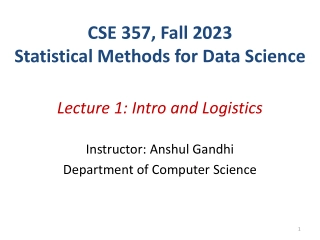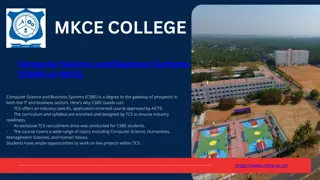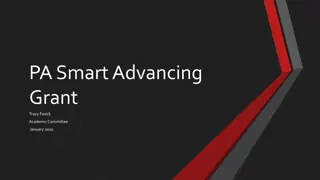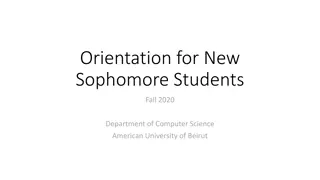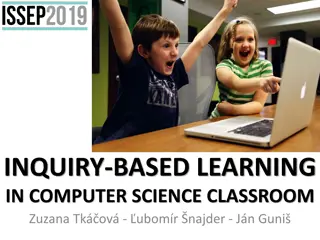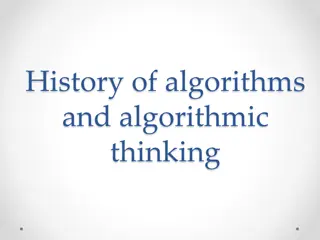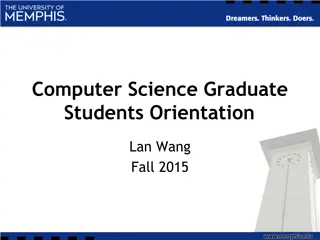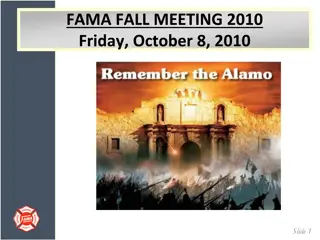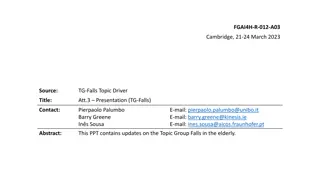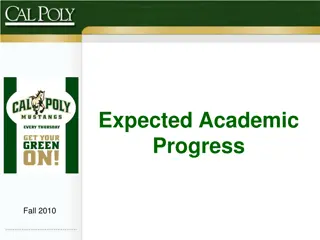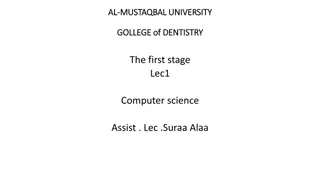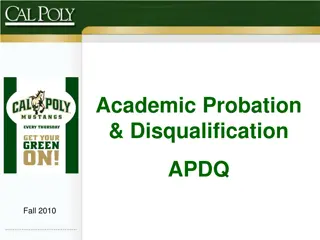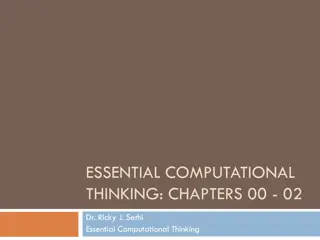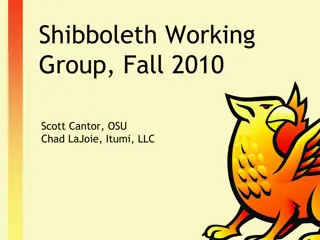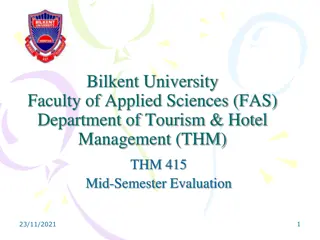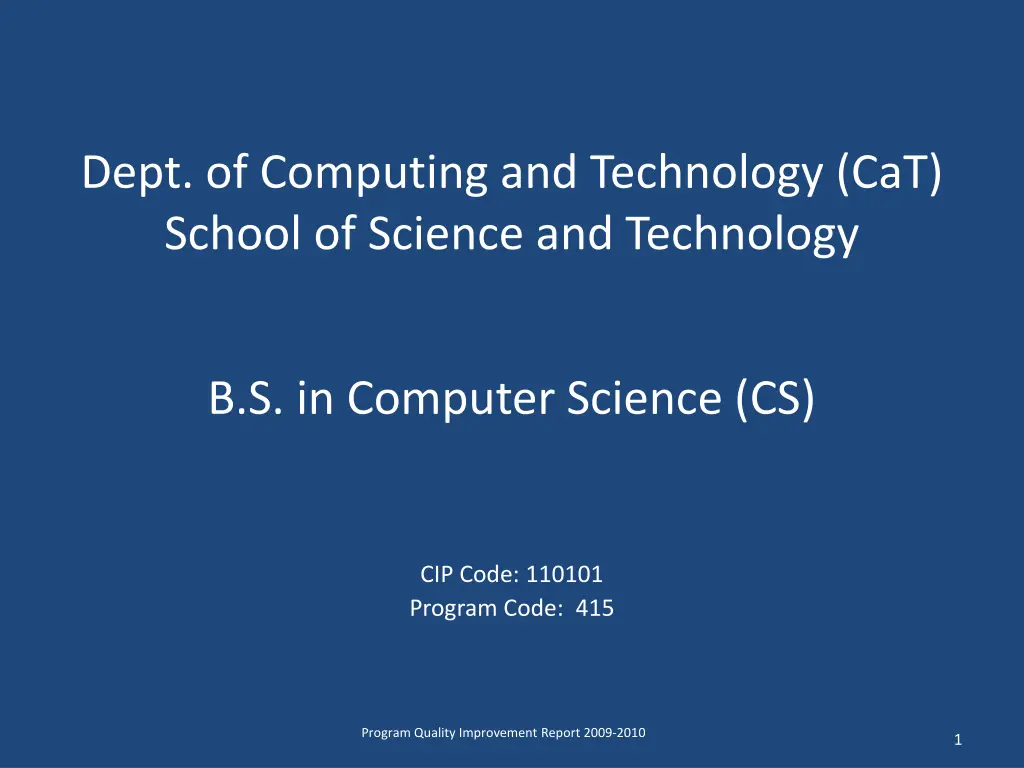
CaT Department of Computing and Technology B.S. in Computer Science Program Report
"Explore the program quality improvement report for the CaT Department of Computing and Technology's B.S. in Computer Science program, including actions taken, student learning outcomes, and alignment with the university mission. Enhance your understanding of curriculum enhancements, assessment tools, and academic goals for students pursuing a career in technology. Dive into the details of entry-level assessments, curriculum planning, and the development of essential skills for budding computer scientists."
Download Presentation

Please find below an Image/Link to download the presentation.
The content on the website is provided AS IS for your information and personal use only. It may not be sold, licensed, or shared on other websites without obtaining consent from the author. If you encounter any issues during the download, it is possible that the publisher has removed the file from their server.
You are allowed to download the files provided on this website for personal or commercial use, subject to the condition that they are used lawfully. All files are the property of their respective owners.
The content on the website is provided AS IS for your information and personal use only. It may not be sold, licensed, or shared on other websites without obtaining consent from the author.
E N D
Presentation Transcript
Dept. of Computing and Technology (CaT) School of Science and Technology B.S. in Computer Science (CS) CIP Code: 110101 Program Code: 415 Program Quality Improvement Report 2009-2010 1
Program actions since last assessment presentation (actions from previous 3 priority outcomes*) 1. Discussed implementing an entry level assessment under the new curriculum. 2. Discussed the position of the midlevel assessment under the new curriculum. 3. Continued including team-work projects in lower division courses CS1313, CS1513, and CS2413. 2
Program actions since last assessment presentation (actions from previous 3 priority outcomes*) 4. Planed to offer the new CS curriculum starting with fall 2010. 5. Began discussions of revising the current assessment tools to be inline with the new curriculum. 3
Student Learning or Service Outcomes General Student Learning Outcomes A-1. Students will possess the necessary knowledge and skills to solve problems using a computer (Bloom s Knowledge). A-2. Students will understand and classify algorithms, structures, and computational systems. (Bloom s Understanding). A-3. Students will be able to apply what they have learned to perform successfully at entry-level positions in industry, or gain admission to graduate/professional schools (Bloom s Application). 4 Program Quality Improvement Report 2009-2010
Student Learning or Service Outcomes Specific Student Learning Outcomes B-1. Be able to design and create computer programs (Bloom s Synthesis). B-2. Demonstrate the ability to evaluate data structures, discrete structures, and algorithms (Bloom s Evaluation). B-3. Be able to analyze computer architectures, operating systems, and networking (Bloom s Analysis). B-4. Demonstrate sufficient professional communication skills. 5 Program Quality Improvement Report 2009-2010
Alignment of Outcomes The B.S. in CS program, as well as all programs in the CaT Dept., support the University Mission in the Cameron University Plan 2013 as stated below Cameron University provides a diverse and dynamic student body access to quality educational opportunities; foster a student-centered academic environment that combines innovative classroom teaching with experiential learning; prepare students for professional success, responsible citizenship, life-long learning, and meaningful contributions to a rapidly changing world; and is a driven force in the cultural life and economic development of the region. 6 Program Quality Improvement Report 2009-2010
Alignment of Outcomes Outcomes A-1, B-1 experiential learning Outcomes A-2, A-3, B-1, B-2, B-3, B-4 professional success Outcome B-1, B-2, B-3, B-4 meaningful contributions to a rapidly changing world 7 Program Quality Improvement Report 2009-2010
Student Learning Outcome Measurements List of Direct Measures of Student Learning Outcomes B-1 Programming Project B-2 CS Skills Examination B-3 National Major Field Assessment Test (MFAT) 8
Student Learning Outcome Measurements List of Indirect Measures of Student Learning Outcomes Exit Surveys 9
Student Learning Outcome Measurements PROGRAM GOAL: A-1 Students will possess the necessary knowledge and skill to solve problems using a computer. MEASUREMENT OF PROGRAM OBJECTIVE Methods used to determine validity of measurement instruments Methods used to determine reliability of measurements CURRICULUM AREA OR TARGET AUDIENCE PROGRAM OBJECTIVE 1 Schedule for measurements Measurements B-1 Programming Fundamentals . Demonstrate the ability to design and create a well- organized computer program. CS 4203 Software Engineering Locally developed programming project (direct) Norm-referenced scores Inter-rater reliability Annually , at the beginning of the Spring Semester 10
Student Learning Outcome Measurements PROGRAM GOAL: A-2 Students will understand and classify algorithms, structures, and computational systems. MEASUREMENT OF PROGRAM OBJECTIVE Methods used to determine validity of measurement instruments Methods used to determine reliability of measurements CURRICULUM AREA OR TARGET AUDIENCE PROGRAM OBJECTIVE 2 Schedule for measurements Measurements B-2 Be able to evaluate data structures and algorithms. CS 4203 Software Engineering Locally developed test (direct) Norm-referenced scores Inter-rater reliability Annually , at the beginning of the Spring Semester 11
Student Learning Outcome Measurements PROGRAM GOAL: A-2 Students will understand and classify algorithms, structures, and computational systems. MEASUREMENT OF PROGRAM OBJECTIVE Methods used to determine validity of measurement instruments Methods used to determine reliability of measurements CURRICULUM AREA OR TARGET AUDIENCE PROGRAM OBJECTIVE 3 Schedule for measurements Measurements B-3 Be able to evaluate different architectures, operating systems, and networking protocols. CS 4203 Software Engineering National MFAT Exam (Major Field Assessment Test) Norm-referenced scores Inter-rater reliability Annually , Spring Semester 12
Display and Analysis of Assessment Data TABLE 1 Results of the Problem Solving Skills (Programming Project) Outcomes A-1, B-1 Spring 2002 2003 2004 F S F S F S 1 100 6 100 4 100 2 90 2 95 4 92 2 85 1 90 1 80 3 80 2 80 1 75 1 70 1 70 1 50 1 0 1 40 Mean 75.9 85.7 94.2 74.2 Std dev. 29 26.4 19.8 6.6 N 12 11 14 9 Spring 2000 F 10 1 2 1 1 1 Mean 96.6 Std dev. 5.4 N 16 Spring 2001 F 3 2 1 1 1 1 1 1 1 Mean 73.3 Spring Spring Spring 2005 F 3 2 1 3 1 2 1 Mean Spring 2006 F 5 1 1 1 1 Mean 84.8 Std dev. 32.4 N 9 Spring 2007 F 2 1 1 1 3 Mean 84.4 Std. dev. 13.5 N 8 Spring 2008 F 3 1 1 1 1 Mean 82.1 Std dev. 21 N 7 Spring 2009 F 4 2 1 1 2 Mean 75.5 Std dev. 40.4 N 10 S S 95 90 85 80 75 70 65 40 0 S S S S S 100 96 94 92 90 80 100 95 80 70 65 60 0 100 90 88 85 0 100 95 90 80 70 100 85 75 72 43 100 95 85 80 0 Mean Mean Std dev. Std dev. Std dev. Std dev. 27.3 N 13 N N N 13 Program Quality Improvement Report 2009-2010
Display and Analysis of Assessment Data TABLE 1 - Problem Solving Skills (Programming Project) Spring 2010 F 2 2 1 1 4 Score Programming Project Mean Score Trends 100 95 90 80 50 120 100 80 60 40 20 0 Mean Std Dev N 76.0 23.1 10 00 01 02 03 04 05 06 07 08 09 10 Program Quality Improvement Report 2009-2010 14
Display and Analysis of Assessment Data TABLE 2 Results of the CS Skills Assessment Outcomes A-2, B-2, B-3 Spring 2003 2004 F S F S 1 95 1 95 1 91 2 87 2 88 1 84 1 87 2 81 2 82 1 80 1 78 2 77 1 77 1 64 1 75 1 68 1 43 1 40 1 24 Mean 72.7 81.3 Std dev 21.6 8.1 N 14 10 Spring 2000 F 1 1 1 2 1 1 2 2 1 1 1 1 1 Mean 77.4 Std dev 11.0 N 16 Spring 2001 F 1 1 1 1 1 1 2 1 1 1 1 Mean 70.3 Std dev 24.4 N 12 Spring 2002 F 1 1 1 1 1 1 3 1 1 Mean 75.5 Std dev 11.9 N 11 Spring Spring 2005 F 2 1 1 1 1 1 1 1 1 1 1 1 Mean 73.7 Std dev 20.7 N 13 Spring 2006 F 1 1 1 2 1 1 1 1 Spring 2007 F 1 1 1 1 2 1 1 Spring 2008 F 1 1 2 1 1 1 Spring 2009 F 1 1 2 1 1 1 1 1 1 S 96 95 88 85 80 78 77 75 74 70 67 62 55 S 95 90 85 80 79 75 73 68 67 58 0 S 93 89 84 82 80 78 70 61 53 S 96 92 90 88 86 76 74 67 64 57 38 35 S 96 93 90 87 79 76 73 41 S 94 93 88 83 70 66 64 S 97 84 78 77 69 43 S 95 94 91 90 85 82 72 67 66 Mean 80.2 Std dev 16.6 N 9 Mean 78.5 Std dev 12.4 N 8 Mean 75.1 Std dev 16.6 N 7 Mean 83.3 Std dev 11.1 N 10 Mean Std dev N 15
Display and Analysis of Assessment Data TABLE 2 CS Skills Exam Assessment Spring 2010 F 1 1 1 1 1 1 1 1 1 Score CS Skills Mean Score Trends 98 96 92 81 77 68 50 44 29 70.1 24.7 9 85 80 75 70 65 60 Mean Std Dev N 00 01 02 03 04 05 06 07 08 09 10 Program Quality Improvement Report 2009-2010 16
Display and Analysis of Assessment Data TABLE 3 Results of the Major Field Achievement Test (MFAT) Outcomes A2, B2, B3 National Statistics 2006-2009 193 Institutions Spring 2007 76 Institutions Spring 2008 Spring 2009 Spring 2010 National Mean Dept. Mean Dept. Mean Dept. Mean Dept. Mean Std. Dev. Mean Programming Fundamentals Discrete Structures, Algorithms Systems (Architecture, Operating Systems, Networking, Database) 57.3 51 71 52 52 55.8 12.6 35.0 30 35 28 35 35.2 8.4 44.2 38 40 36 42 42.8 9.3 Overall Scores 142 153 142 146 148.6 9.7 *Score range for overall means 120-200 17
Display and Analysis of Assessment Data Discrete Structures, Algorithms Programming Fundamentals 80 70 40 60 50 30 40 20 30 20 10 10 0 0 2007 2008 2009 2010 2007 2008 2009 2010 Systems (Arch, Net, OS, DB) Overall Scores 44 155 42 150 40 145 38 36 140 34 135 32 2007 2008 2009 2010 2007 2008 2009 2010 Program Quality Improvement Report 2009-2010 18
Display and Analysis of Assessment Data TABLE 4 Results of the Exit Survey Spring 2008 Number Surveyed: 10 Strongly Agree Strongly Disagree Question Agree Neutral Disagree 1. The computer science curriculum has given me a firm grounding in mathematics and the sciences. 2. As a result of my education I feel confident of my abilities to utilize computer science principles to identify, formulate, and solve computer science problems. 3. I am proficient in the application of these principles in the design of computer software. 4. I feel I have gained the ability to communicate effectively, both orally and in writing, with technical and non-technical audiences. 5. The CS program has helped me to work effectively, independently, and on teams within the discipline and across disciplines. 67% 33% 33% 67% 17% 83% 50% 50% 67% 33% Program Quality Improvement Report 2009-2010 19
Display and Analysis of Assessment Data TABLE 4 Results of the Exit Survey Spring 2009 Number Surveyed: 3 Strongly Agree Strongly Disagree Question Agree Neutral Disagree 1. The computer science curriculum has given me a firm grounding in mathematics and the sciences. 2. As a result of my education I feel confident of my abilities to utilize computer science principles to identify, formulate, and solve computer science problems. 3. I am proficient in the application of these principles in the design of computer software. 4. I feel I have gained the ability to communicate effectively, both orally and in writing, with technical and non-technical audiences. 5. The CS program has helped me to work effectively, independently, And on teams within the discipline and across disciplines. 67% 33% 67% 33% 33% 67% 67% 33% 67% 33% 20
Display and Analysis of Assessment Data TABLE 4 Continued Results of the Exit Survey Spring 2010 Number Surveyed: 7 Strongly Agree Strongly Disagree Question Agree Neutral Disagree 1. The computer science curriculum has given me a firm grounding in mathematics and the sciences. 2. As a result of my education I feel confident of my abilities to utilize computer science principles to identify, formulate, and solve computer science problems. 3. I am proficient in the application of these principles in the design of computer software. 4. I feel I have gained the ability to communicate effectively, both orally and in writing, with technical and non-technical audiences. 5. The CS program has helped me to work effectively, independently, and on teams within the discipline and across disciplines. 71% 29% 86% 14% 14% 86% 14% 72% 14% 43% 57% Program Quality Improvement Report 2009-2010 21
Action plan for Student-Learning or Service Outcomes Update the student learning outcome measurements to be inline with the new CS curriculum Update the requirements for the CS minor to be inline with the new CS curriculum 22 Program Quality Improvement Report 2009-2010

